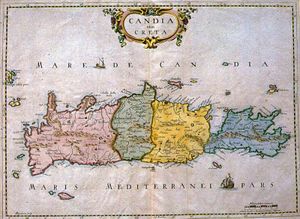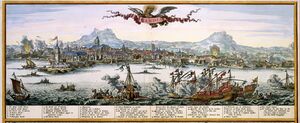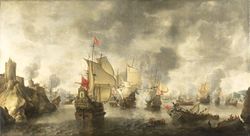حرب كريت (1645-1669)
| ||||||||||||||||||||||||||
حرب كريت (باليونانية: Κρητικός Πόλεμος، بالتركية: Girit'in Fethi) أو حرب كاندية (إيطالية: Guerra di Candia)، تشتهر بالحرب العثمانية البندقية الخامسة، كان نزاع بين جمهورية البندقية وحلفائها (على رأسهم فرسان مالطا، الدويلات البابوية وفرنسا) ضد الدولة العثمانية والدويلات البربرية، على جزيرة كريت، أكبر وأغنى أراضي بندقية وراء البحار. استمرت الحرب من عام 1645 حتى 1669 وكان القتال في كريت ووقعت عدد من الاشتباكات والغارات حول بحر إيجة، وكانت دلماتيا المسرح الثاني للعمليات العسكرية.
بلغ الصراع ذروته بحملة الدردنيل البندقية، وبحصار كاندية الشهير الذي دام 22 عاماً بين عامي 1647 و1669 عند الاستسلام النهائي ولعله يكون أطول حصار في التاريخ .[2]
الأسباب
في القرن السابع عشر بدأت كفة العثمانيين ترجح بشكل شبه حاسم في صراعهم الطويل والمضني مع البنادقة للسيطرة على شرق البحر المتوسط.
تضآلت أراضي البندقية الشاسعة خارج الأدرياتي تدريجياً جتى انحصرت بجزيرة كريت والجزر الأيونية، وكان العثمانيون يبحثون عن ذريعة للتخلص من هذه المعاقل الأخيرة لسلطة البندقية السابقة.
وقد وجدوا سبباً في عام 1644 بهجوم فرسان مالطا في 28 سبتمبر على قافلة عثمانية متجهة من الأسكندرية إلى اسطنبول قرب رودس، كانت تحمل فيه ثروة هائلة وبعض من حريم السلطان في عودتهم من الحج. استراحت الفرقة البحرية المالطية في ميناء كاندية عاصمة الجزيرة، للتزود قبل أن تقلع من جديد. فكان هذا العمل البسيط كافياً لنسف الجهود المضنية الرامية لإحلال السلام بين البندقية والعثمانيين.
حشد الباب العالي قوة من 60.000 جندي تحت قيادة يوسف باشا ، كانت ظاهرياً بعثة تأديبية على مالطا، ولكن البنادقة أُخذوا على حين غرة بوصول الأسطول العثماني في 26 يونيو 1645.
استولى العثمانيون على خانيا في 17 أغسطس بعد شهرين الحصار، ولكن لـّما عاد السلاحدار يوسف باشا عاد إلى القسطنطينية شتاءاً، وأخطأ في حق السلطان وأُعدم. رغم ذلك تقدم العثمانيون تقدماً لا بأس به بأخذهم ريثيمنو في أوائل 1646. وتناقصت تدريجياً معاقل البندقية في أنحاء الجزيرة. قبل حلول عام 1648، كانت كريت في أيدي العثمانيين، باستثناء كانديا وعدد قليل من المعاقل مثل گرامفوزا.
الحرب
العمليات المبكرة في كريت
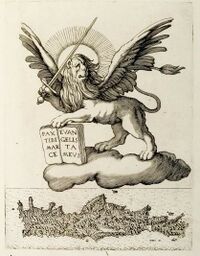
The Venetians were indeed fooled by the Ottoman subterfuge and were taken by surprise at the arrival of the Ottoman fleet at Crete on 23 June 1645.[3] Despite the efforts of the recently appointed provveditore generale, Andrea Corner, the Venetian defenses were still in a bad state.[4] The island's fortifications were substantial, but they had been long neglected, and much effort was put into repairing them.[5] Anxious about Ottoman preparations, the Republic reinforced Crete in late 1644 with 2,500 troops and provisions, and began arming its fleet, while assistance was promised in the event of war by the Pope and Tuscany.[6]
بدء حصار كاندية
The siege began in May 1648. The Ottomans spent three months investing the city, which included cutting off the water supply. Eventually, it would last until 1669, the second longest siege in history after the Siege of Ceuta (1694-1727) by the Moors under Moulay Ismail.[7] The Ottoman besiegers were adversely affected by the bad supply situation caused by the activity of the Christian fleets in the Aegean, who intercepted Ottoman convoys carrying supplies and reinforcements to the island.[8] In addition, the overall Ottoman war effort was severely hampered by increased domestic instability caused by Sultan Ibrahim's erratic policies and his summary execution of leading state officials. It ultimately led to his deposition in favor of his son Mehmed IV, ushering in a further period of confusion within the Ottoman government.[9]
الحرب البحرية
- لقائمة كاملة للاشتباكات البحرية، انظر المعارك البحرية في حرب كريت (1645-69)
الاشتباكات المبكرة 1645–1654

معارك الدردنيل، 1654–1657
التعادل 1658–1666
الطور الأخير من الحرب 1666–1669
الاستيلاء على كاندية

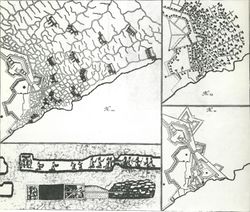
الحرب في دلماتيا

المصادر
- ^ Paoletti, Ciro (2008). A Military History of Italy. p. 33.
- ^ "حرب كريت". البسالة.
- ^ خطأ استشهاد: وسم
<ref>غير صحيح؛ لا نص تم توفيره للمراجع المسماةSetton126 - ^ Setton (1991), p. 120
- ^ Setton (1991), p. 107
- ^ Setton (1991), p. 121
- ^ The Siege of Candia is often cited as "the longest siege on record", (e.g. by
 Chisholm, Hugh, ed. (1911). . دائرة المعارف البريطانية. Vol. 7 (eleventh ed.). Cambridge University Press. p. 427.
Chisholm, Hugh, ed. (1911). . دائرة المعارف البريطانية. Vol. 7 (eleventh ed.). Cambridge University Press. p. 427. {{cite encyclopedia}}: Cite has empty unknown parameter:|coauthors=(help)). Nevertheless, the blockade and siege of Ceuta, variously given as lasting until 1720 ( Chisholm, Hugh, ed. (1911). . دائرة المعارف البريطانية. Vol. 5 (eleventh ed.). Cambridge University Press. p. 777.
Chisholm, Hugh, ed. (1911). . دائرة المعارف البريطانية. Vol. 5 (eleventh ed.). Cambridge University Press. p. 777. {{cite encyclopedia}}: Cite has empty unknown parameter:|coauthors=(help)) or until Moulay's death in 1727 Archived 14 مايو 2011 at the Wayback Machine, was longer. - ^ خطأ استشهاد: وسم
<ref>غير صحيح؛ لا نص تم توفيره للمراجع المسماةSetton150 - ^ Setton (1991), pp. 151–153
المراجع
- Cooper, J. P. (1979), The New Cambridge Modern History, Volume IV: The Decline of Spain and the Thirty Years War, 1609–48/59, CUP Archive, ISBN 978-0-521-29713-4
- Detorakis, Theocharis E. (1986) (in Greek), Ιστορία της Κρήτης, Athens, OCLC 17550333
- Duffy, Christopher (1979), Siege Warfare, Routledge, ISBN 978-0-7100-8871-0
- Faroqhi, Suraiya (2006), The Ottoman Empire and the World Around It, I.B. Tauris, ISBN 978-1-84511-122-9
- Finkel, Caroline (2006), Osman's Dream: The Story of the Ottoman Empire 1300–1923, London: John Murray, ISBN 978-0-7195-6112-2
- Finlay, George (1856), The History of Greece under Othoman and Venetian Domination, London: William Blackwood and Sons
- Fleet, Kate; Faroqhi, Suraiya; Kasaba, Reşat (2006), The Cambridge history of Turkey: the later Ottoman Empire, 1603-1839, Cambridge University Press, ISBN 978-0-521-62095-6, http://books.google.com/?id=g9UfRAnZzU4C
- Greene, Molly (2000), A Shared World: Christians and Muslims in the Early Modern Mediterranean, Princeton University Press, ISBN 978-0-691-00898-1
- Holt, P. M.; Lambton, Ann K. S.; Lewis, Bernard (1978), The Central Islamic Lands from Pre-Islamic Times to the First World War, Cambridge University Press, ISBN 978-0-521-29135-4
- Lane, Frederic Chapin (1973), Venice, a Maritime Republic, JHU Press, ISBN 978-0-8018-1460-0, http://books.google.com/?id=PQpU2JGJCMwC
- Miller, William, Essays on the Latin Orient, Cambridge University Press Archive, http://books.google.com/?id=Wcw7AAAAIAAJ
- Murphey, Rhoads; Black, Jeremy (1999), Ottoman warfare, 1500–1700, Routledge, ISBN 978-1-85728-389-1
- Nicolle, David (1989), The Venetian Empire, 1200–1670, Osprey Publishing, ISBN 978-0-85045-899-2
- Parry, Vernon J.; Cook, M. A. (1976), A History of the Ottoman Empire to 1730: Chapters from the Cambridge History of Islam and the New Cambridge Modern History, CUP Archive, ISBN 978-0-521-09991-2
- Setton, Kenneth Meyer (1991), Venice, Austria, and the Turks in the Seventeenth Century, DIANE Publishing, ISBN 0-87169-192-2
- Shaw, Stanford Jay; Shaw, Ezel Kural (1976), History of the Ottoman Empire and Modern Turkey: Empire of the Gazis - The Rise and Decline of the Ottoman Empire, 1280–1808, Cambridge University Press, ISBN 978-0-521-29163-7
- Turnbull, Stephen (2003), The Ottoman Empire 1326–1699, Routledge, ISBN 978-0-415-96913-0
- (باليونانية) Tzompanaki, Chrysoula (2008), Ο Κρητικός Πόλεμος 1645–1669: Η Μεγάλη Πολιορκία και η Εποποιϊα του Χάνδακα, Heraklion, ISBN 978-960-92052-4-5
- (باليونانية) Vakalopoulos, Apostolos E. (1968), Ιστορία του νέου ελληνισμού, Τόμος Γ′: Τουρκοκρατία 1453–1669, Thessaloniki: Emm. Sfakianakis & Sons
وصلات خارجية
 Media related to Cretan War at Wikimedia Commons
Media related to Cretan War at Wikimedia Commons- Municipality of Heraklion: The Cretan War
- Venice and the Sea, by the VENIVA consortium (in English, Greek, Italian).
- Venice Republic: Renaissance, 1645–69
- مقالات المعرفة المحتوية على معلومات من دائرة المعارف البريطانية طبعة 1911
- Short description is different from Wikidata
- Articles containing Greek-language text
- Articles containing إيطالية-language text
- Pages using Lang-xx templates
- Articles with hatnote templates targeting a nonexistent page
- نزاعات القرن 17
- القرن 17 في اليونان
- حروب فرسان الإسبتارية
- الحروب العثمانية البندقية
- حروب الدويلات البابوية
- حروب ماني
- حروب مالطا
- حروب كاندية
- كريت العثمانية
- تاريخ دلماتيا
- القرن 17 في الدولة العثمانية
- عقد 1640 في الدولة العثمانية
- عقد 1650 في الدولة العثمانية
- عقد 1660 في الدولة العثمانية
- نزاعات في القرن 17
- حروب الدولة البابوية
- حروب الدولة العثمانية
